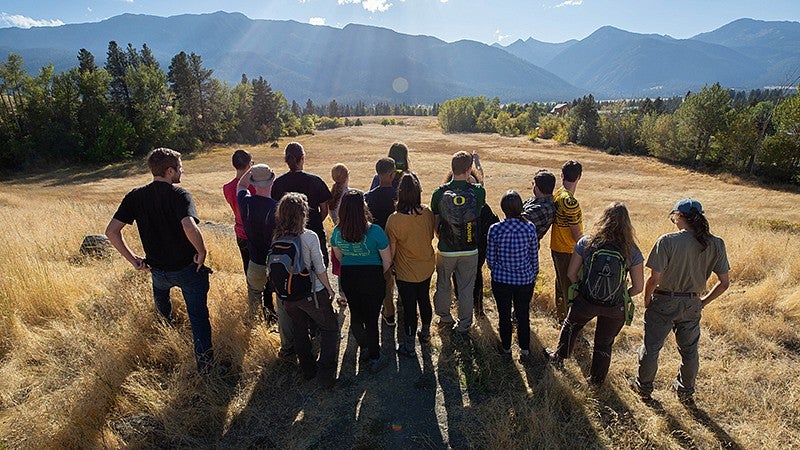
Tracking Conflict And The Wolf
Students travel the state to study management of the predator and how to bridge divides on any issue
By Emily Halnon • Photo by Charlie Litchfield • January 11, 2019
12 min read
Thousands of people cross the border between Oregon and Idaho every day without anyone batting an eye. On one day about 13 years ago, another Idahoan left the Gem State for its western neighbor and, like many of the travelers before him, went totally unnoticed as he passed over the state line.
But once his arrival amid Oregon’s firs and farms became known, this ramblin’ man added fuel to a fiery debate that has been raging across the state for two decades.
This controversial crosser was a shaggy black wolf who would soon be known as OR4, after the Oregon Department of Fish and Wildlife assumed management of him from their counterpart in Idaho. He was not the first wolf to migrate west in recent years, but after he ambled deeper into Oregon’s wilderness, he clinched the honor of being a more lasting first.
The wandering wolf took a liking to the rugged Wallowa Mountains and settled down in a hollow ponderosa tree with his smoky-furred lady friend, a fellow traveler from Idaho who would be dubbed OR2. Amid slopes of towering evergreens and the churning waters of the Imnaha River, the drifter duo made themselves at home.
Together, they started the first pack of wolves in the state since 1947—and a contentious conversation about how to manage these animals in Oregon went from theory to reality.
Peg Boulay, a UO environmental studies instructor, will tell you that when it comes to wolf management, there are many viewpoints and no easy answers.
Ranchers lament the loss of their livestock to these large carnivores. Environmentalists laud their contributions to a healthy ecosystem.
Some people would be ecstatic to eliminate every wolf in Oregon, while others don’t want a single one harmed. Many fall somewhere in the middle.
The individuals responsible for drafting and upholding the state’s wolf management plan know how complicated the issue is. The plan’s 189 pages outnumber the entire statewide wolf population, currently estimated at about 125 animals.
That’s one thing stakeholders in the wolf management issue can agree on: it’s complicated.
Wolves are no friends to ranchers but they help the ecosystem by keeping elk populations in check. Photo courtesy of Oregon Department of Fish and WildlifeBoulay saw the complexities of this thorny environmental issue as a learning opportunity. She recognized that it represents a collision of ecological, sociological, and political factors. She noted the tensions between rural and urban values, the divide between the east and west sides of the state, and rifts between federal and state policy.
So she turned the challenges of wolf management into a new course that leverages this hot-button issue into an avenue for students to consider diverse and conflicting interests and address problems in collaborative ways.
“These students will have to face daunting and intricate environmental problems as future professionals,” says Boulay, who received a grant from the Tom and Carol Williams Fund for Undergraduate Education to design the class.
“This course uses wolves as a timely case study to help students explore how to deal with conflict in constructive, catalyzing ways.”
Tents, Trail Mix, and 1,300 Miles in a Van
When Boulay started mapping out the syllabus for Wolves: Conversations in Conservation and Controversy, she firmly believed the most effective way to teach students about this issue could not be done solely in the classroom.
Instead, on September 16, the week before fall term began, 15 curious students loaded into two large vans crammed with camping gear, Coleman stoves, and trail mix galore. They pointed the vehicles north and hit the highway, armed with thoughtful questions and open ears.
Boulay orchestrated an eight-day, 1,338-mile road trip around northeastern Oregon so the students could hear from the stakeholders themselves. These juniors and seniors spent the final week of summer break in 10 meetings with 15 ranchers, environmentalists, hunters, tribal members, and agency representatives, learning the intricacies of this prickly issue.
The students hopped on conference calls, hiked through the Wallowa-Whitman National Forest, and hosted fireside chats to engage people with diverse viewpoints in discussions of wolf conservation and management. It didn’t take long for them to appreciate just how challenging this matter is.
When senior Sky Ramirez-Doble climbed into the van in Eugene, he believed science would emerge as an obvious tool to inform policy decisions about wolf management. As an environmental science major, he draws from research and data to tackle environmental problem-solving. He expected to find a similar approach effective during meetings in Salem, Joseph, Pendleton, and five other Oregon towns and cities.
Instead, Ramirez-Doble quickly discovered that science wasn’t going to offer any silver bullet solution to managing the 12 wolf packs in Oregon.
Boulay (back row, blue-plaid shirt) used the wolf issue to teach respect for conflicting opinions. Photo by Charlie Litchfield, University Communications“I learned that there’s a lot of disagreement about what wolves even mean to an ecosystem,” he says. “It was really surprising to hear that the science wasn’t solid. There were so many different numbers and bits of information referenced during our meetings.”
To further complicate the issue, most of the limited, existing research has been conducted in areas such as Yellowstone National Park in Wyoming, with drastically different landscapes and biodiversity from where wolves have settled in Oregon.
Ecosystem Ally or Problematic Predator?
The role of wolves in an ecosystem is one of the pillars of the debate around their management. The animals are native to Oregon, but were eradicated through aggressive bounty offerings established in 1843. Wolves have long been demonized as a threat to human and animal safety and Oregon is far from the only place that’s tried to chase them away for good.
Think about the fairy tales and stories you read as a child. They didn’t star a big, bad kitten. Little Red Riding Hood wasn’t trying to escape an evil panda.
“Wolves have been portrayed as bloodthirsty killers as well as powerful leaders, unrestrained loners, and symbols of dwindling wildness,” Boulay says. “Wolves evoke strong emotions in people.”
While wolves may have received an unfair share of public shaming, they are still carnivores. And they do prey on living animals. Sometimes elk, sometimes deer, sometimes cattle.
Environmentalists say they contribute to a balanced ecosystem. By keeping the elk population in check, for example, wolves help control grazing, which prevents stream and river erosion and ensures trees and plants can grow.
But when wolves feast on livestock, ranchers and others take umbrage. Through 2017, there were 177 confirmed livestock or domestic animal losses in Oregon attributed to wolves in the last two decades. The number of suspected or possible losses is even higher.
“I came into the course thinking the controversy with wolves was mostly over safety and loss of human life, but soon saw it was more of a concern about loss to livelihood,” says senior Hunter Mackin, who is majoring in environmental science and economics.
The students spoke with ranchers in Baker County about how the reemergence of wolves has affected their operations and bottom line. They even spent a blustery night camped out on a working ranch in Unity. They spread their sleeping bags across a small patch of land that rests among 8,000 sprawling acres where cattle graze and roam.
As cows dined on tufts of grass, the students learned more about raising cattle in wolf territory—and what happens when a wolf turns a cow into his breakfast.
“So many of the issues stem from loss of cattle,” says Ramirez-Doble.
A large component of the state’s wolf management plan helps ranchers with the financial hit from losing cattle, which are known in the field as “depredations.”
ODFW biologists placing a new GPS collar on OR4, the Imnaha wolf pack's alpha male, after darting him from a helicopter. Photo courtesy of Oregon Department of Fish and WildlifeBut compensation for these incidents is not as straightforward as it may sound. There’s the matter of pegging the death to a wolf with complete certainty, which isn’t always easy, especially on large swaths of land where cattle roam for days without human oversight.
And there’s the limited depth of the state’s budget. While ranchers want reimbursement, many also want funds channeled to deterrence strategies such as using radio collars to track the wolves, boosting the number of agency representatives to respond to depredations, or installing fencing that fends off predators.
“And it’s not just the actual loss of cattle,” says senior Drew Donahue, who is majoring in environmental studies. “We heard ranchers outline what happens when wolves chase cattle. The cows use more energy and that leads to fewer fat reserves, which translates to less income. And ranchers also report that they’ve seen reproductive rates go down. They don’t get compensated for any of that.”
After a wolf kills a number of cows, some ranchers argue for what’s known as a “lethal take,” when the Oregon Department of Fish and Wildlife kills the wolf pegged to the depredations. But what qualifies as enough kills? And does the elimination of a single wolf stop the problem? And how does the loss of a wolf alter the ecosystem and the pack’s behavior?
“Even among ranchers, there are a lot of different viewpoints and takes on potential solutions and methods of deterrence,” says Mackin. “It’s really difficult to find a solution because every case is so different, with ranchers and with wolf packs.”
Campfire Conversations
The uncertainties surrounding wolves and their management provided fuel for campfire discussions every night, while the students debriefed after their conversations with stakeholders.
That was part of their daily routine. While every meeting they had was drastically different, there was a formulaic approach to the field trip.
Boulay roused them out of their rainbow of tents at an hour only a rooster could love, and they got to work making breakfast while the waking sunlight dripped onto their campsite. The students each had chores—cooking and cleaning and breaking down gear. They divided and conquered camp life.
They also divided and conquered the field work itself. The students were split into five groups to spearhead conversations with each group of stakeholders—ranchers, environmentalists, hunters, tribes, and agencies. Each group conducted research and then educated their classmates about the ins and outs of that stakeholder group’s perspective, to drive informed conversations and equip each other to ask strategic and thoughtful questions.
The students were taught how to approach contentious conversations in respectful and productive ways. Environmental studies instructor Katie Lynch trained them in ethnographic skills that use interviews and observations to study cultures and people. They learned how to frame questions in a way that invited honest dialogue and they practiced empathetic listening to gain a better understanding of the underlying values, assumptions, fears, and hopes that drive one’s views.
“The goal was to make sure none of our questions were leading, combative, or confrontational, but instead geared toward fostering open discussion, digging deeper, and leading to new insights,” says Boulay.
Then each night, they sat around crackling flames, huddled as close to the fire’s belly as they could stand to escape the freezing air, and outlined takeaways from the day—for example, the inconsistent understanding of the animal’s biological impact, the role of money and income, and the unpredictability of wolf behavior.
Inspired by Political Gridlock
The matter of listening—or rather, not listening—was the genesis for the class. The course has roots in the 2016 presidential election, when Boulay was frustrated with the widespread divisiveness and political gridlock that followed.
A male from the Wenaha pack, fitted with a radio collar in 2010. Photo courtesy of Oregon Department of Fish and Wildlife“In this increasingly polarized climate, it seems no one is listening to each other,” she says. “We’re not collaborating on policy solutions.”
Boulay asked herself how could she use her classes to help students enter this charged arena with better listening skills and the tools to promote greater understanding? She wanted to help her students learn how to table preconceived stereotypes and engage in conversations with an open mind and the ability to work through competing interests.
That’s when it hit her: what better venue to hone those skills than wolf management and conservation in Oregon?
“It’s timely, it’s relevant, it’s particularly difficult,” says Boulay. “It’s almost unsolvable.”
Mackin, Ramirez-Doble, and Donahue agree that they didn’t emerge from the field trip with any obvious solutions to wolf management. “Our ideas about how to manage wolves changed after every single meeting,” says Mackin, shaking his head slowly.
Instead, they returned to Eugene with a deeper appreciation for the difficulty of the issue—which they continued to explore during the fall term through more interviews, class sessions, an interdisciplinary project, and a meeting of the Wolf Plan Stakeholder Representatives Working Group in Salem.
“The students witnessed the proposals, negotiations, arguments, alliances, and facilitation inherent in developing policy options,” says Boulay. “Watching some of their interviewees interact with each other was a defining moment that pulled together their entire field experience. And all of the stakeholders seemed truly happy to see the students again.”
They all concurred that they couldn’t have internalized the issue’s complexities as meaningfully through only a textbook or lectures. It was while wandering vast sagelands and ambling through thick forests and huddling around a campfire that the students saw and heard firsthand that the matter of wolf management is as gray as the fur that covered OR2.
“There is such a spectrum of opinions, even within one group of stakeholders,” Mackin says. He talked about visiting with the Umatilla tribe and, even within that one community, hearing several viewpoints.
The students also agree on one factor that seems critical to progress: respectful dialogue.
“I found that when I’m face-to-face with someone telling me their concerns and feelings, it really got me to table my own biases and see a bigger and more complete picture,” says Mackin.
They were encouraged by examples of how approaching a thorny environmental issue with an open mind and a sincere desire to listen can bridge divides: a wildlife advocacy group that started the first compensation program for depredations; a pair of environmentalists who helped a pair of ranchers stranded by a flat tire; a fish and wildlife agent who immediately shows up to consider every cattle loss because he cares for people and their livelihood.
Through 15 perspectives and 1,338 miles, Boulay’s class learned that people can passionately disagree on something but still respect each other and want to find a solution that incorporates competing values and views.
“Coming away from every meeting, we developed a connection with every person,” Donahue says, with eager optimism. “Every single person we met with saw collaboration as a desirable path forward.”
Emily Halnon is a staff writer with University Communications.




